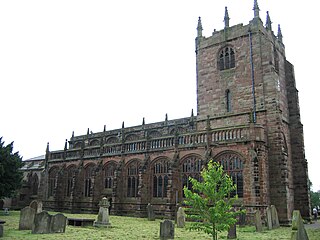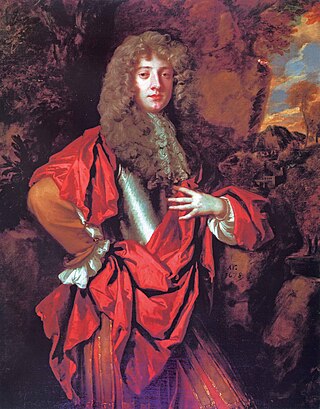
Sir William Dugdale was an English antiquary and herald. As a scholar he was influential in the development of medieval history as an academic subject.

Heraldic visitations were tours of inspection undertaken by Kings of Arms throughout England, Wales and Ireland. Their purpose was to register and regulate the coats of arms of nobility, gentry and boroughs, and to record pedigrees. They took place from 1530 to 1688, and their records provide important source material for historians and genealogists.
Sir Richard Grosvenor, 1st Baronet was an English politician who sat in the House of Commons at various times between 1621 and 1629. He is an ancestor of the modern day Dukes of Westminster.

John Souch was an English portrait painter. He flourished in the early seventeenth century in the North West of England, and perhaps epitomises the role of art in English local life at that time.

St Boniface's Church stands prominently in the village of Bunbury, Cheshire, England. It is recorded in the National Heritage List for England as a designated Grade I listed building. The church dates mainly from the 14th century. Its features include the Ridley chapel, the alabaster chest tomb of Sir Hugh Calveley and the tomb of Sir George Beeston. Raymond Richards, author of Old Cheshire Churches, considers it is architecturally one of the most important examples of its period in Cheshire. Alec Clifton-Taylor includes it in his list of 'best' English parish churches, and Simon Jenkins assigns it two stars in his book England's Thousand Best Churches. It is an active Anglican parish church in the diocese of Chester, the archdeaconry of Chester and the deanery of Malpas. Its benefice is combined with that of St Jude, Tilstone Fearnall.

St Peter's Church is in Eastgate Street in the centre of the city of Chester, Cheshire, England, immediately to the north of Chester Cross. It is recorded in the National Heritage List for England as a designated Grade I listed building. It is an active Church of England parish church in the diocese of Chester, the archdeaconry of Chester and the deanery of Chester. The ancient walls mark the boundaries of the parish.

St Mary's Creative Space, formerly the Church of St Mary-on-the-Hill, stands at the top of St Mary's Hill, Chester, Cheshire, England, near Chester Castle. It is recorded in the National Heritage List for England as a designated Grade I listed building. The church stands at the top of a narrow winding lane which leads down to the River Dee, and it is adjacent to Chester Castle. In the 1970s the church was converted into an educational centre. It is currently available for use as a concert and exhibition venue and the Chester Music Society hold many concerts there throughout the year. The venue is programmed by Theatre in the Quarter, and hosts a variety of art and cultural events, from homegrown Cestrian performers, national and international acts.

St Andrew's Church is in the village of Tarvin, Cheshire, England. The church is recorded in the National Heritage List for England as a designated Grade I listed building. It is an active Anglican parish church in the diocese of Chester, the archdeaconry of Chester and the deanery of Chester. Its benefice is united with that of St Peter, Duddon.

St James' Church is in the village of Audlem in south Cheshire, England. It is recorded in the National Heritage List for England as a designated Grade I listed building.

St Oswald's Church is in the village of Backford, to the northwest of Chester, Cheshire, England, close to the A41 road and adjoining Backford Hall. It is recorded in the National Heritage List for England as a designated Grade II* listed building. The church dates from the 14th century with later additions and restorations. It contains one of the few surviving aumbries in Cheshire and a number of memorial boards painted by the Randle Holme family. It is an active Anglican parish church in the diocese of Chester, the archdeaconry of Chester and the deanery of Wirral South. Its benefice is combined with that of Holy Trinity Church, Capenhurst. From March 2018 this benefice shares a vicar with All Saints, Saughall.

St Chad's Church is in the village of Farndon, Cheshire, England. It is an active Anglican parish church in the diocese of Chester, the archdeaconry of Chester and the deanery of Malpas. Its benefice is combined with that of St Mary, Coddington. The church is recorded in the National Heritage List for England as a designated Grade II* listed building.

St John the Baptist's Church is in the town of Knutsford, Cheshire, England. The church is recorded in the National Heritage List for England as a designated Grade II* listed building. It is an active Anglican parish church in the diocese of Chester, the archdeaconry of Macclesfield and the deanery of Knutsford. Its benefice is combined with that of St John the Evangelist, Toft.

Sir Peter Leycester, 1st Baronet was an English antiquarian and historian. He was involved in the English Civil War on the royalist side and was subsequently made a baronet. He later compiled one of the earliest histories of the county of Cheshire and as a result of this became involved in a controversy with the Mainwaring family. He developed a library in his home at Tabley Old Hall and made improvements to the house and estate, including building a private chapel in the grounds of the house. He was an active and conscientious justice of the peace, and used his position on the Bench to expound his staunchly conservative and Royalist political views.

St Lawrence's Church is in the village of Stoak, Cheshire, England,. The church is recorded in the National Heritage List for England as a designated Grade II* listed building. It is an active Anglican parish church in the diocese of Chester, the archdeaconry of Chester, the deanery of Wirral South and the Ellesmere Port team ministry.

St Helen's Church is in the village of Tarporley, Cheshire, England. It is an active Anglican parish church in the diocese of Chester, the archdeaconry of Chester and the deanery of Malpas. Its benefice is united with those of St John and Holy Cross, Cotebrook, St Thomas, Eaton, and St Paul, Utkinton. The church is recorded in the National Heritage List for England as a designated Grade II* listed building.

St Mary's Church is a redundant Anglican church in the small village of Thornton-le-Moors, Cheshire, England. The church is recorded in the National Heritage List for England as a designated Grade I listed building, and it is in the care of the Churches Conservation Trust.

St Mary's Church is in the village of Pulford, Cheshire, England. The church is recorded in the National Heritage List for England as a designated Grade II* listed building. It is an active Anglican parish church in the diocese of Chester, the archdeaconry of Chester and the deanery of Chester. Its benefice is combined with that of St Mary, Eccleston.

The Leghs of Lyme were a gentry family seated at Lyme Park in Cheshire, England, from 1398 until 1946, when the stately home and its surrounding parkland were donated by the 3rd Lord Newton to The National Trust.

Sir Thomas Grosvenor, 3rd Baronet was an English Member of Parliament, and an ancestor of the modern day Dukes of Westminster. He was the first member of the family to build a substantial house on the present site of Eaton Hall in Cheshire.
George Mainwaring was an English Member of Parliament and a member of a distinguished family line from Cheshire.


















